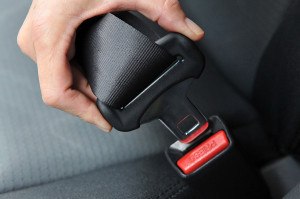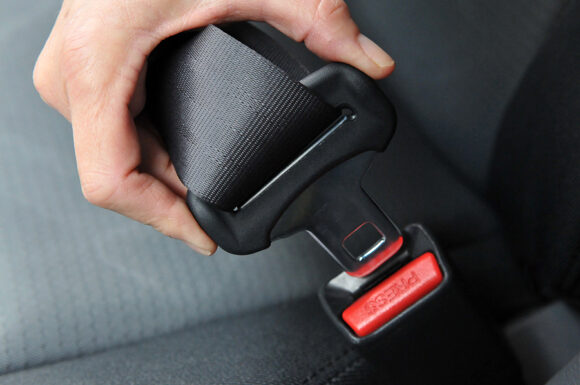Vehicle crashes are the leading cause of death and injury among children. Kansas State University civil engineers are striving to increase child safety by studying a simple action: buckling up.
The engineers — Sunanda Dissanayake, associate professor of civil engineering, and Niranga Amarasingha, a postdoctoral researcher in civil engineering — have found the most effective strategy to prevent injury and death among children is to use age- and size-appropriate seatbelt restraints.
Nearly 97 percent of children under the age of 4 use safety restraints, according to 2010 observational surveys in Kansas. But only 76 percent of older children — ages 4 to 13 years old — use seatbelts, even though motor vehicle crashes are the No. 1 killer for that age group.
“Children are the innocent victims in vehicle crashes,” Dissanayake said. “They are just sitting in the car and yet they are involved in crashes. We want to see why these crashes are happening and what characteristics they have when children are involved. We want to understand why these seatbelt numbers are low and how to improve them to keep children safe.”
The engineers have partnered with the Kansas Department of Transportation and the Kansas Transportation Research and New Developments, or K-TRAN, program. The researchers studied state databases that contain information about vehicle crashes from 2004 to 2008. During that time, children ages 4 to 13 were involved in 50,155 crashes in Kansas.
The researchers studied children ages 4 to 13 because of Kansas child restraint laws, which require children ages 4 to 7 to be secured in a booster seat — unless they weigh more than 80 pounds or are taller than 57 inches — and children ages 8 to 13 to be protected by a seatbelt. In 2010 Kansas legislators passed a primary seatbelt law, which requires all passengers who are 14 years or older to wear a seatbelt. While seat belt usage in Kansas has risen in recent years, there is still much room for improvement, Dissanayake said.
“We really want to know why young children have low seat belt usage because this is an area that can easily be improved,” Dissanayake said. “Children will not be on their own in a car. They will always be with an adult, and that adult can ask the child to buckle up.”
When analyzing data, the engineers found several factors made it less likely for a child to buckle up. Children were less likely to use seatbelts if the driver was intoxicated, if the driver was not buckled up and if the child was riding in an older vehicle. The type of car also affected seatbelt usage. Children in pick-up trucks had the lowest seatbelt usage rate, children in cars had better seatbelt usage rates, and children in SUVs and vans used seat belts the most.
The most frequent factors that contributed to Kansas crashes involving children were inattentive driving, failure to yield right of way, driving too fast, wet roads and animals in the road. The crash factor also affected seatbelt usage. For example, 96 percent of children were using seatbelts during crashes caused by improper turn or following a car too closely, while 74 percent of children were using seatbelts during crashes caused by reckless or careless driving. Other factors, such as the driver not following license restrictions, also involved low seatbelt usage by children.
“There is a connection between the cause of the crash and seatbelt usage,” Dissanayake said.
Seatbelt usage also related to children’s injury severity, Dissanayake said. Crash-related injury levels included: fatal injuries, incapacitating injuries, non-incapacitating injuries, possible injury and no injury.
Seatbelt usage gradually increased as injuries became less severe, which shows the effectiveness of seat belts in saving lives. More than 84 percent of uninjured children in vehicle crashes were wearing seatbelts, yet only 40 percent of children with fatal injuries were using seatbelts at the time of the crash.
“It is so important to save these lives by doing the simple task of just buckling up,” Dissanayake said.
In addition to using age- and size-appropriate restraints among children, the researchers developed countermeasures to improve children’s seatbelt usage. The countermeasures fall into three categories:
1. Education,which is twofold and includes educating parents about the dangers of not buckling up and educating children about the importance of using seatbelts.
2. Enforcement,which includes law enforcement, random check points, advertising and community enforcement campaigns to make sure people are using age- and size-appropriate seatbelt restraints.
3. Engineering,which includes road enhancements such as rumble strips to alert drivers when starting to drift, improved horizontal curves and better signs to make the road less complex.
The researchers are preparing their work for publication. They are also performing another study about young drivers.
Source: Kansas State University
Was this article valuable?
Here are more articles you may enjoy.


 Flooding in California Leads to Soaked Roads, Water Rescues and 1 Death
Flooding in California Leads to Soaked Roads, Water Rescues and 1 Death  ‘Door Knocker’ Roofers Were Everywhere. NC Farm Bureau Saw an Opportunity
‘Door Knocker’ Roofers Were Everywhere. NC Farm Bureau Saw an Opportunity  Wells Fargo Sued by Ex-Manager Who Said Bank Faked Diversity
Wells Fargo Sued by Ex-Manager Who Said Bank Faked Diversity  Apollo Expands Asset-Level Risk Reviews to Reflect Impact of Extreme Weather
Apollo Expands Asset-Level Risk Reviews to Reflect Impact of Extreme Weather 